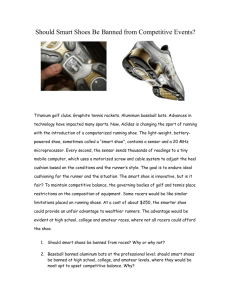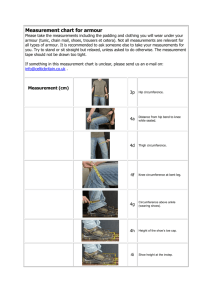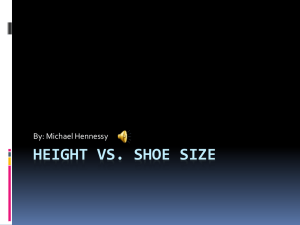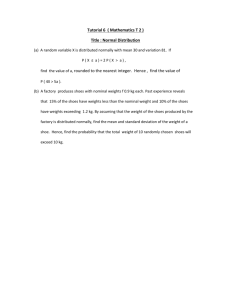MS Word - The Physics Classroom
advertisement
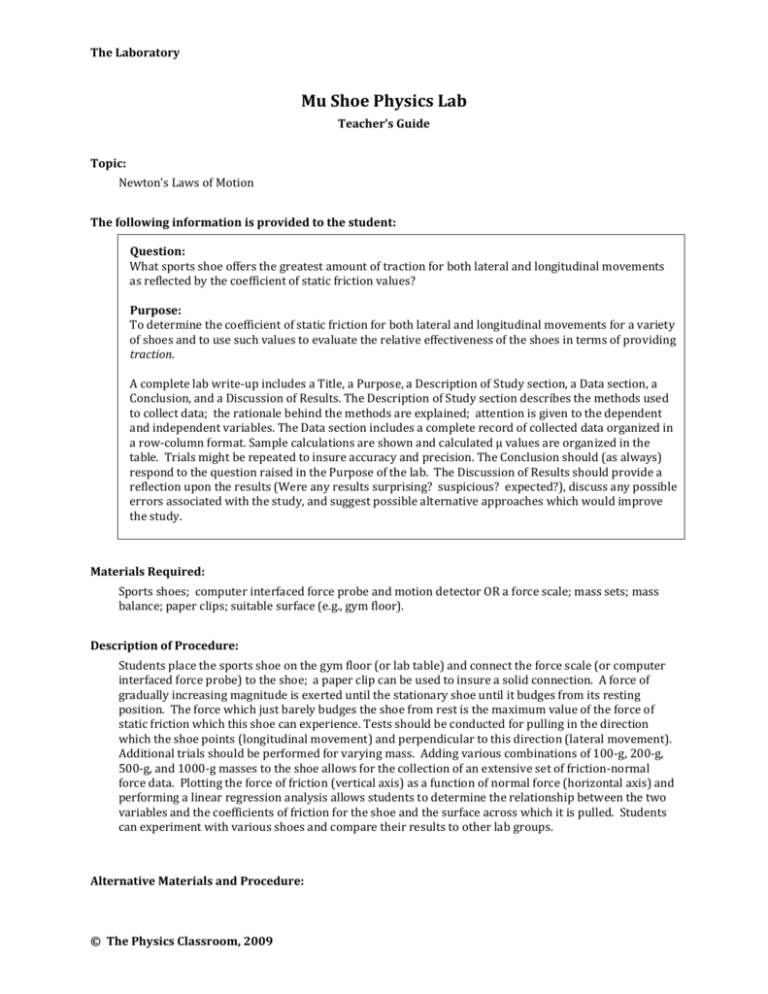
The Laboratory Mu Shoe Physics Lab Teacher’s Guide Topic: Newton's Laws of Motion The following information is provided to the student: Question: What sports shoe offers the greatest amount of traction for both lateral and longitudinal movements as reflected by the coefficient of static friction values? Purpose: To determine the coefficient of static friction for both lateral and longitudinal movements for a variety of shoes and to use such values to evaluate the relative effectiveness of the shoes in terms of providing traction. A complete lab write-up includes a Title, a Purpose, a Description of Study section, a Data section, a Conclusion, and a Discussion of Results. The Description of Study section describes the methods used to collect data; the rationale behind the methods are explained; attention is given to the dependent and independent variables. The Data section includes a complete record of collected data organized in a row-column format. Sample calculations are shown and calculated µ values are organized in the table. Trials might be repeated to insure accuracy and precision. The Conclusion should (as always) respond to the question raised in the Purpose of the lab. The Discussion of Results should provide a reflection upon the results (Were any results surprising? suspicious? expected?), discuss any possible errors associated with the study, and suggest possible alternative approaches which would improve the study. Materials Required: Sports shoes; computer interfaced force probe and motion detector OR a force scale; mass sets; mass balance; paper clips; suitable surface (e.g., gym floor). Description of Procedure: Students place the sports shoe on the gym floor (or lab table) and connect the force scale (or computer interfaced force probe) to the shoe; a paper clip can be used to insure a solid connection. A force of gradually increasing magnitude is exerted until the stationary shoe until it budges from its resting position. The force which just barely budges the shoe from rest is the maximum value of the force of static friction which this shoe can experience. Tests should be conducted for pulling in the direction which the shoe points (longitudinal movement) and perpendicular to this direction (lateral movement). Additional trials should be performed for varying mass. Adding various combinations of 100-g, 200-g, 500-g, and 1000-g masses to the shoe allows for the collection of an extensive set of friction-normal force data. Plotting the force of friction (vertical axis) as a function of normal force (horizontal axis) and performing a linear regression analysis allows students to determine the relationship between the two variables and the coefficients of friction for the shoe and the surface across which it is pulled. Students can experiment with various shoes and compare their results to other lab groups. Alternative Materials and Procedure: © The Physics Classroom, 2009 The Laboratory Conducting the lab on a gym floor makes the results more authentic. Alternatively, any surface (e.g., lab table surface) could be used. If conducting the lab on a lab bench, the computer-interfaced force probe can be used. If conducting the lab in a gymnasium, the force scale should be used. Safety Concern: There is always a higher than usual level of risk associated with working in a science lab. Teachers should be aware of this and take the necessary precautions to insure that the working environment is as safe as possible. Student horseplay and off-task behaviors should not be tolerated. Suggestions, Precautions, Notes: 1. 2. 3. 4. 4. This lab activity can be performed as a substitute for the Friction Lab or as a more interesting follow-up activity. The focus of this lab is on the static friction coefficient. Class results can be pooled for interesting analysis. Students can post their coefficient values for the various brands of gym shoes. If mass balances are not widely available, the mass of all the shoes to be tested should be determined in the classroom in advance of leaving for the gym. Remind students to pull parallel to the floor. A parallel pull will balance the friction force for a static situation. An angled pull will introduce error. Depending on the quality of the class and the amount of exposure to the topic, this lab often requires extensive preparation. It is important that students understand the theory behind the procedure. Auxiliary Materials: None Scoring Rubric: NL9. Mu Shoe Physics Lab Included, labeled and organized all parts of the lab report. Description of Study section describes the methods used to conduct the study. Includes diagram where relevant. Discussed details regarding how the shoes were pulled and the direction of pull, how the normal and the friction forces were measured and the range of values used. The rationale behind such methods was clearly, thoroughly and accurately explained. Data section includes a table of collected data; units were included. Trials were repeated to insure reliable results; averaging was conducted. Coefficients of static friction for at least three shoes were calculated for both longitudinal and lateral movements. Work is shown for calculations. Conclusion states all coefficient values and ranks the shoes according to relative effectiveness for providing traction. Conclusions are clear and complete. Discussion of Results provides a reflection upon the results of the study. Errors are analyzed and alternative approaches are suggested. Connections to The Physics Classroom Tutorial: The following readings are a suitable accompaniment to this lab: http://www.physicsclassroom.com/Class/newtlaws/u2l1d.cfm http://www.physicsclassroom.com/Class/newtlaws/u2l2b.cfm http://www.physicsclassroom.com/Class/newtlaws/u2l2c.cfm © The Physics Classroom, 2009 Score _____/_____ The Laboratory Connections to Minds on Physics Internet Modules: Sublevels 4 and 5 of the Newton’s Law module is a suitable accompaniment to this lab: http://www.physicsclassroom.com/mop/module.cfm © The Physics Classroom, 2009

